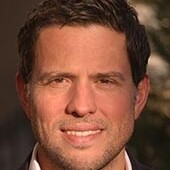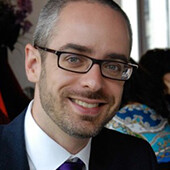Filmmaker Steve Dorst explores how America solved the ozone crisis in his new film Shattered Sky, comparing it to our confrontation with climate change today. The film will premiere on U.S. public television in September 2012 to coincide with the twenty-fifth anniversary of the ozone treaty signed by the Reagan Administration.
EVAN O'NEIL: Steve, the main theme of Shattered Sky is that the world came together to solve the ozone crisis and needs to unite again on global warming. What motivated you to tell this story?
STEVE DORST: I first learned about the ozone story in 2007, when it was Bush's second term and there was a lot of pent-up demand to finally do something on climate. Through a mutual friend I got to meet President Reagan's Secretary of State George Shultz, who helped lead the charge to an international ozone treaty. When we spoke he told me: " I look back on U.S. leadership on securing this treaty as one of my proudest accomplishments as Secretary of State." From then on I was hooked. I spent the next two years traveling the country interviewing people from the front lines of ozone and climate—scientists, business people, and diplomats. I wanted to know why we're so stuck on climate today, whereas we solved ozone during the Reagan Administration. How was that possible? The more I dug into the story, the more I suspected it might inspire us to work together to solve climate change.
EVAN O'NEIL: How strong is the analogy between climate and ozone?
STEVE DORST: There are three big parallels: the science, the civics, and the battle. First, with regard to the science: Emissions from manmade technologies cause both problems—CFCs rip a hole in the ozone layer, and carbon dioxide and other gases cause global warming. Both types of pollution persist for a long time in the atmosphere, so even if you sharply reduce emissions, it takes a while to reverse the damage. The march of science has been key—hypotheses drew attention, then empirical evidence helped make the case for more concerted action.
Second, the civics. In both situations, the public outcry was significant, but there is a real prisoner's dilemma. Emissions don't respect borders, so no single country can solve the problem on its own initiative—solutions require global agreements, which are difficult to achieve.
Third, the political battles have been epic. Business stands to lose the most, with billions of dollars invested in the offending technologies. As a result, industry spares no expense opposing change. So in both ozone and climate, you have high stakes, big risks, and uncertain consequences—all the makings of a good film!
EVAN O'NEIL: Where do the two problems diverge?
STEVE DORST: The big difference is that America led the world to a solution during the ozone crisis. The climate problem is more complex, since it's inextricably linked to our global energy infrastructure. But people forget how revolutionary and ubiquitous CFCs were at the time. They were critical components in billions of dollars of equipment around the world. They ushered in our modern way of life since they were essential for refrigeration, advanced solvents, and air conditioning. The ozone crisis was also extraordinarily complex.
EVAN O'NEIL: What about the ethics of the two issues?
STEVE DORST: Right. When you start to think about how to phase out CFCs or carbon dioxide, it gives rise to questions of global inequity. You have to look at historical emissions because the gases stay in the atmosphere for so long. During the ozone negotiations, China and India emphasized that less than 25 percent of the world's population was responsible for more than 90 percent of emissions. Today, some people counter that carbon emissions are different—because India's emissions exceed Germany's, South Korea exceeds France, and China exceeds the United States. But you can't just look at today. You have to look back to the advent of the Industrial Revolution. Since 1850, the United States has emitted about 29 percent of global greenhouse gas emissions, the European Union 27 percent, and China 8 percent.
EVAN O'NEIL: So America has a historical responsibility to act. What about China, the largest emitter?
STEVE DORST: China presents a red herring. The GDP per person in the United States is about five times that of China. My parents taught me that being a good person of character means taking responsibility for my own actions. I believe that being a good country in the global community is not so different. It's well past time for the United States to take responsibility, get its own house in order, and lead the world to a fair global treaty. Only then can we use our influence to prompt China into cutting emissions. Or we figure out another method like a green tariff to eliminate their trade advantage and force their hand. Until then, American politicians who concentrate on China are cowards.
EVAN O'NEIL: But China's per capita emissions have nearly drawn equal with Europe's, their growth trend shows little intention of slowing down, and they have been underestimating their emissions data by some 20 percent. Does their right to dirty development trump the severity of their current contribution to the problem?
STEVE DORST: China's not the main player here. This is the American moment.
EVAN O'NEIL: The United States imports green technologies like cheap solar panels from China. Wouldn't a trade war hurt efforts to decarbonize both sides?
STEVE DORST: I agree, we don't want a trade war. But with Europe and United States aligned on the issue, China would be obliged to follow our lead.
EVAN O'NEIL: Getting back to the film: What made the Montreal Protocol such a success?
STEVE DORST: While making the film, I learned that the Montreal Protocol wasn't perfect, but it was a good start. For me, the protocol's pattern of "start and strengthen" is a great lesson in solving climate change. In 1987, 25 countries negotiated under the banner of the United Nations Environmental Programme and agreed to cut CFC production by 50 percent. Then, seeing those initial goals could be met, gradually other countries signed on and moved to a 100 percent phaseout of a larger group of chemicals.
In recognition of their historic responsibility, rich countries capitalized a dedicated Multilateral Fund to help with technology transfer and ensure the phaseout in poorer countries. Signatories met on an annual base to work out the details. That's where the real magic happened—hammering out the nuts-and-bolts implementation. Today, 197 countries are signatories to the Montreal Protocol and 98 percent of all ozone-depleting substances have been phased out.
Bottom line, for a climate treaty to work, it's more important to have a committed United States than a perfect treaty.
EVAN O'NEIL: After disarray at recent environmental summits, many are questioning whether multilateral diplomacy is still relevant. Do you agree?
It's more important to have a committed United States than a perfect treaty.
STEVE DORST: Without a committed United States, multilateral climate diplomacy is a sham. A journalist friend of mine calls these summits "donuts"—there's no action in the center without America driving a substantive agreement. All the energy is on the sidelines, with the networking and conversation. But ultimately it's empty calories. Ambassador Richard Benedick, who helped negotiate the Montreal Protocol in 1987, calls contemporary summits "medieval trade fairs." He makes the point that ozone diplomacy involved a handful of countries, largely under the radar. By contrast, these days you have tens of thousands of people descending on the meetings in Copenhagen, Cancun, and elsewhere. It's chaos. That's why, without the United States on board, future summits are destined to be disappointments.
EVAN O'NEIL: What will it take for the United States to lead on climate?
STEVE DORST: You and me and our neighbors listening to our own conscience! Do we want to do right by our children and grandchildren? Do we want to own up to the emissions that have helped us become a rich country? If so, let's all speak up on this issue. That's why I made Shattered Sky, because a lot of us don't realize that the Reagan Administration led the world to a solution on the ozone crisis. We can work together on this issue domestically and internationally.
EVAN O'NEIL: You plan to use the film as an educational tool. How will that work?
STEVE DORST: I'm convinced that if our young people learn how America led the world on the ozone crisis, then we'll be one step closer to solving climate change. Shattered Sky has partnered with National Wildlife Federation to develop a national science and civics curriculum for middle-school and high-school students. NWF has more than 50,000 teachers in its network, meaning the curriculum will potentially reach hundreds of thousands of students.
EVAN O'NEIL: How does an independent film like this get made? How do you fund it?
STEVE DORST: I funded most of Shattered Sky myself, gradually making the film between my work as an independent director, cinematographer, and editor here in the Washington, D.C. area. I'm in the home stretch right now finishing the film and working with Maryland Public Television to get it on air. If people want to help with that effort—and with the educational curriculum—I invite them to check out our ongoing Shattered Sky Kickstarter campaign.
EVAN O'NEIL: Do you think global warming will factor in the 2012 U.S. presidential election?
STEVE DORST: It's incredibly tragic that climate and energy is not even on the radar of our presidential candidates. For that reason, I'm launching a petition calling on President Obama and Mitt Romney to rise above petty electoral politics and take inspiration from the ozone story—when America solved a big environmental problem during the Reagan Administration. The petition demands that our presidential candidates discuss their plans for a fair national energy policy that addresses climate change.
EVAN O'NEIL: So if readers want to watch the film, where can they see it?
STEVE DORST: Shattered Sky will premiere on September 16, 2012 on U.S. public television—timed with the twenty-fifth anniversary of the Montreal Protocol. Co-director Dan Evans and I made our festival premiere at the D.C. Environmental Film Fest in March.
EVAN O'NEIL: Steve, thanks so much for chatting with Policy Innovations.
STEVE DORST: Thanks! Really enjoyed it.
ExxonMobil CEO Rex Tillerson recently said we will adapt to climate change, declaring it an "engineering problem." Imagine if we had listened to the people advocating hats and sunglasses as a solution to the ozone hole.





